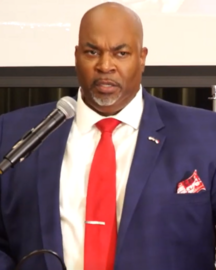This man is tackling the post-hurricane terror scape with energy, efficiency and compassion. And he is pissed at the Federal government. He is building his own private disaster response team in Western North Carolina.
Mark Robinson has partnered with private jet owners and is currently flying supplies to Hurricane Helene victims in Western North Carolina
— George (@BehizyTweets) October 1, 2024
How is this not national news right now?
"We’ve successfully scaled our team up to a 24/7 operation. This would not be possible without the… pic.twitter.com/tiBaC5aEIP
Right now, medics are being prevented from accessing the high hills and people are reporting the appearance of cash buyers for their land. Maybe it’s a good time to note that there’s Lithium in them there hills.

Mark Robinson, as the Lieutenant Governor of North Carolina, holds an interesting position that intertwines legislative and executive responsibilities. He serves as the ex officio president of the State Senate, giving him a voice in legislative proceedings, and he’s a member of the Council of State, influencing a range of state policies. His role also includes acting as governor in the governor’s absence, which necessitates involvement in state emergency responses.
Following a recent hurricane, Lieutenant Governor Robinson has been visibly active in response efforts. He has publicly criticized the perceived slow response from federal levels, notably mentioning that he felt more could be done immediately to assist Western North Carolina, an area severely affected.
Robinson has been pushing for immediate action, urging Democrat Governor Roy Cooper to deploy more resources, including the National Guard, and has notably facilitated the distribution of aid through partnerships with local law enforcement, showcasing a hands-on approach in crisis management.
In contrast, federal efforts under President Biden have been portrayed by Robinson as lacking, with claims that more could be done faster. This discrepancy highlights a common tension between state and federal responses, where states often seek faster, more direct aid, whereas federal responses can be perceived as slower due to bureaucracy.
He's making FEMA LOOK TERRIBLE!
— TruVote (@mytruvote) October 1, 2024
The Mouthpiece Media is covering for Kamala since she was UNABLE to answer ANY QUESTIONS about the Hurricane victims.https://t.co/X0VfyLeDNX
Robinson’s approach emphasizes local and state mobilization, urging a reduction in bureaucratic hurdles to expedite aid, which contrasts with what he perceives as the federal government’s slower, more procedural response. This situation underscores the ongoing debate on the efficiency of disaster response at different governmental levels.
Joe Biden told the people of North Carolina they had no more supplies for us.
— Mark Robinson (@markrobinsonNC) October 1, 2024
I called Franklin County Sheriff Kevin White & he said “that’s BS.”
Franklin County has been running round the clock convoys on behalf of my office since Saturday night.
Their deputies have not… pic.twitter.com/2MbWjihKxv
In times of crisis, true strength is revealed. LT. Gov. @markrobinsonNC ’s unwavering commitment and decisive action prove he is a true leader, not just a politician.
— Sandy Smith NC (@SandySmithNC) October 1, 2024
God Bless Mark Robinson.#VoteMarkRobinson2024 #ncpol #Leadership https://t.co/UdjOYxy39x